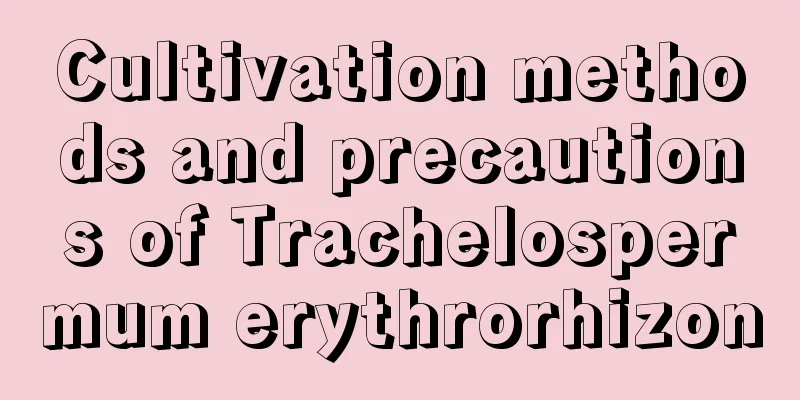Cultivation methods and precautions of Trachelospermum erythrorhizon

How to cultivate Trachelospermum jasminoidesPot soil selectionTrachelospermum jasminoides can be planted in pots or in the ground. The shape of potted Trachelospermum jasminoides can be made according to the grower's own preferences. Trachelospermum jasminoides has strong adaptability to soil. The potting soil can be slightly acidic or neutral. Weakly alkaline soil can also be used, but its growth will be poor. Generally, garden soil can be chosen, and some leaf mold can be added. Light and temperatureTrachelospermum prefers a warm, semi-shady growing environment. It can withstand cold and heat, but avoids severe cold. It likes weak light, but can withstand strong sunlight. When growing Trachelospermum jasminoides, you can place it in a sunny place to ensure sufficient light. In spring, autumn and winter, you can place the ivy in a sunny place. In summer, you need to shade it under strong sunlight or move it to a semi-shaded place. Trachelospermum jasminoides is cold-resistant, but its cold resistance is not very strong. When the temperature is too low, you can place the Trachelospermum jasminoides in a warm room to overwinter. Water and fertilizer managementTrachelospermum jasminoides prefers a moist growing environment and can tolerate a certain degree of drought, but is afraid of waterlogging and requires the soil to have a certain level of fertility. During the growing season, the potting soil of the Trachelospermum jasmine needs to be kept moist. In spring and autumn, you can water it every two days, in summer you can water it once a day, and in winter you need to water it less often, once every half a month. Pay attention to the rainy season to drain water and avoid waterlogging. Trachelospermum likes fertilizer, but it can also tolerate barrenness. It can bloom with less fertilizer, but it will have adverse effects. In order to make the ivy spathiphyllum bloom more, you can apply more phosphorus fertilizer and potassium fertilizer. Usually, you can apply compound fertilizer once in spring and autumn, and no fertilizer is required in winter and summer. Things to note when growing Trachelospermum erythrorhizomeReproduction methodWhen propagating Trachelospermum jasmine, the preferred method is layering. Cuttings can be used, but the survival rate is lower. You can also choose the standard method, but the cycle is longer and it takes three or four years to bloom. Pests and diseasesThere are relatively few diseases and pests on Ichthyophthirius, and the main thing is to prevent and control some pests according to conventional disease and pest control methods. |
<<: Cultivation methods and precautions of peach
>>: Pearl orange cultivation methods and precautions
Recommend
How long does it take for a lemon tree to grow?
Introduction to Lemon Tree Growth When planting l...
When is the right time to repot the fairy finger (Precautions and techniques for repotting the fairy finger)
When is the best time to repot the fairy finger? ...
How to disinfect and sterilize the soil used for growing flowers (disinfection method of flower potting soil)
1) Sun exposure method In sunny weather, first sp...
Can forsythia be propagated by cuttings?
There are many methods of propagating Forsythia, ...
How does Zixuanyue spend the winter?
temperature The best growing conditions for Purpl...
How to make Kalanchoe bloom more and grow bigger and stronger?
1. How to grow up and become strong 1. Receive su...
Cultivation methods and precautions of red flower
1. Soil The red flower genus is very resistant to...
When to plant tomatoes in spring
April is the best time to plant tomatoes. Althoug...
What is the best month to plant bamboo leaf vegetables?
When to plant bamboo leaf vegetable Bamboo leaf v...
How to grow strawberries well
Strawberry Growing Conditions Strawberry has stro...
How to store yam for a long time? How to store yam for a long time
1. Low temperature storage The most common way to...
Advantages and disadvantages of the night rose
The flowers of the true night rose are small in s...
How to open a durian
1. Pry open from the crack Mature durian usually ...
How to repair the broken leaves of succulent plants
1. Dry the wound During normal maintenance, you m...
How many corn plants are planted per acre to achieve the highest yield (how many high-yield corn plants are planted per acre to increase yield)
The selection of a local corn variety is highly c...









